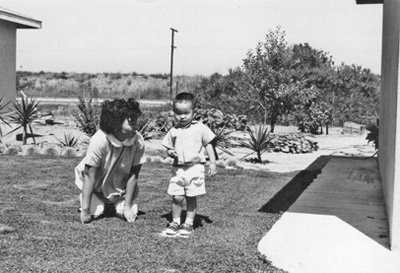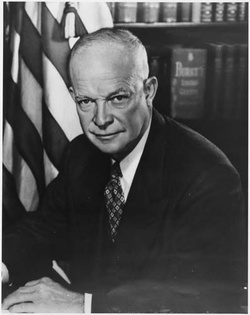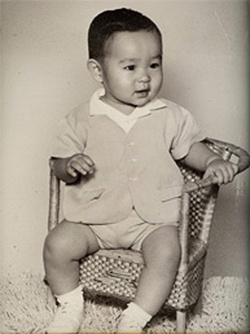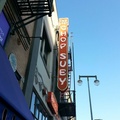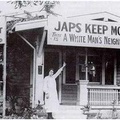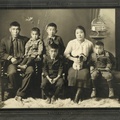All parents ruminate on what to name their child.
They go through baby-naming books. Suggestions from family and friends. Fads of the day. Boy, girl, the process is nearly ceaseless. Sleepless nights. And even after the baby is born, there are still days, perhaps weeks that go by with nary a name but the sex of the child.
I have the extra benefit of being Japanese American. Traditionally, many third and fourth generation JAs had a Japanese middle name. It was optional. A number of my cousins did not.
My mom wanted a girl. She professed to me as an adult that she always wanted a girl (yeah, that made me feel special). But she never regretted having a boy. Make that two boys.
She wanted to name me Peggy.
Peggy? Okay, there was Peggy Lee and Peggy Cass. The truth was she liked Peggy Fleming, the figure skater.
For my dad, he had a strong inkling that he’d have a boy. He came from an all-boy family (he’s the youngest of five). His father was one of five boys back in Hiroshima. He said he didn’t have any preference—boy, girl, it was all good. But if indeed it was a boy, he had the name all picked out.
“Dwight David”
That’s right, after good ol’ Ike himself. Dwight David Eisenhower. General. President. A guy who’s profile graced a dollar coin and a highway system named after him. That Dwight David.
My dad loved Ike. Still does. “One of the finest U.S. Presidents there ever was,” he’d exclaim. “Next to Richard Milhous Nixon,” he’d continue. Dad was a U.S. Army veteran of World War II, U.S. Occupational Forces in Japan, and the Korean War. He was a staunch Republican and voted for Eisenhower and Nixon in the mid fifties.
Also, Eisenhower’s grandson was named after him.
If it was good enough for Ike, it was good enough for me.
So dad picked Dwight David, or rather David Dwight. And mom, well, she was a big Kennedy fan. If I were to be a boy, it was tit for tat, I’d be named John, sans the Fitzgerald.
It could have been worse. My dad could have named me Richard Milhous.
On a cold and windy Tuesday morning in February, I was born. Trash day. My mom always brought that up for some reason. Before she went into labor, she made sure she took the trashcans to the curb.
At any rate, I was named David Dwight.
I hated the name Dwight. Besides being “dorky,” kids my age didn’t have a clue who Eisenhower was. I doubt young people today would make that connection.
So what about my Japanese name?
It’s Kiyoshi.
So my full name is David Dwight Kiyoshi. Add to that my four-syllable surname, Toyoshima, and you have a mouthful. I have enough problems with “Toyoshima.” People will pronounce it, “Tomashimo, Toyotashima, Takashima, Tohoshymah…” Don’t get me started.
I’d explain my last name was simple. It was basically two words combined. “Toyo” meant “plentiful” and “shima” meant “island.”
Okay, back to Kiyoshi.
In Japanese, it means “pure.” Also “quiet, bright, clean, and shining” (part of that sounds like an ad for laundry detergent). My parents told me it meant “pure of heart.” They also told me it had some significance to the outdoors and nature. Whether or not those “traits” are reflective of my personality are subjective. I am on the “quiet side.” I do love nature. Pure of heart? Well, I’m not exactly a saint…
I asked my mom once why she and dad gave me a Japanese name. She said it was a way of preserving our cultural heritage. None of them had Anglo names. Well, sort of. Like many Niseis, they adopted one. My mom, Kazue, was abbreviated to Kay. And my dad, for some odd reason, went from Shizuo to Pete. Pete? Ever since his days in the Army, the “white guys” could never pronounce Shizuo. Not even when he shortened it to “Shiz.”
I was quick to drop Dwight. But it took me a while to acknowledge Kiyoshi.
I grew up in a time when being Japanese or Asian was tough enough. Memories of World War II were still raw. We were American citizens, but we were still seen by many as “them.” “Those Japs.” My parents and their family were sent to relocation camps, Manzanar and Heart Mountain. After the war, they returned to Southern California to find many cities and neighborhoods boycotting Japanese Americans from buying homes.
“We don’t want you here. Go back to Japan,” placards read.
My parents eventually found a home in a small corner of West Long Beach, California. Even in Long Beach, the east side and Wrigleyville communities made it clear they didn’t want Japanese Americans.
When I began grade school, I was one of a handful of JA kids. The class was predominantly Caucasian and a few African Americans and Asian Pacific Islanders.
So, there I was. This pint-sized Asian kid (I was small for my age). Shy, quiet—I never felt like I fit in. Bullies would tease me about being Japanese. Come Pearl Harbor Day, they’d scream “sneak attack!” Some kid called me “Tojo.” What the hell was a Tojo? They pulled the corners of their eyes to make slanty eyes. Shoved me around asking me to fight back with karate or kung fu.
It was then I didn’t want to be Japanese. Or Asian for that matter.
While I had dropped my middle name Dwight, I didn’t disclose my Japanese middle name, Kiyoshi.
“Kiyoshi” seemed worse. Even more “Japanesy.”
For a long time, I would simply go by “Dave Toyo.”
I knew I had all this history to be proud of—my grandparents (on my mother’s side) born in Hawaii. Cutting sugar cane in the blistering sun. They bought a farm and were truck farmers in what is now Monterey Park. Sent to internment camps, losing everything except the shirts on their back. My dad and my uncles all war veterans.
It wasn’t until my grandmother Ishi (my mom’s mom) died that I’d come to embrace my ethnicity.
I was in my last year of college when Obaa-chan passed away at ninety-seven years old.
She watched me when I was a kid, when my mom went off to work. She made me lunch. Often just a bowl of rice with pickled vegetables and hot green tea. She tried to teach me to speak and understand Japanese (as a kid, I refused to go to the local Buddhist Temple where they had a Japanese language school. I regret not going now).
She taught me origami. I still have those old children’s books on the art of paper folding.
My grandparent’s house was the hub of Japanese culture for our entire family. New Years (shogatsu) were spent making mochi by hand. My grandfather and uncles took turns pounding the hot, sweet sticky rice with their monster wooden mallet. The “women folk” and the kids formed the mochi balls. Some were filled with sweet red bean paste—my favorite. By the end, I was covered in rice flour.
Those were happy times.
When Ojii-chan and Obaa-chan died and their house sold, my connection to my cultural heritage evaporated. Or so it seemed. I decided that I’d make shogatsu dinner each year. Okay, I did buy the mochi.
I began writing and studying the history of my family: beginning in Hiroshima as rice farmers in the mid to late 1800s, their immigration to Hawaii, truck farmers in Central and Southern California. And their internment during WWII.
I had this duality within me. I was Japanese. And I was American. With my grandparents and mom gone, I felt that I needed to keep my cultural heritage alive. I wasn’t simply Japanese or American. I was Japanese American.
I was David Kiyoshi. And proud of it.
But don’t call me Dwight. I’d rather keep a lid on that.
© 2014 David Toyoshima


